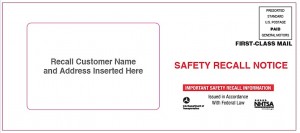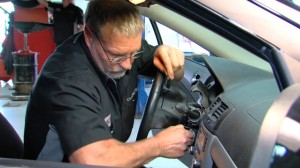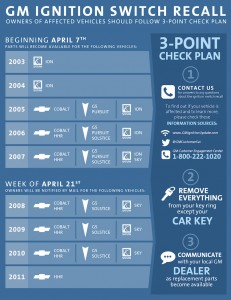
If you find this in your mailbox, don't panic. Open it to find out what you need to do to ensure your vehicle is safe to drive.
Due to the sheer number of vehicles recalled in the United States this year – in excess of 40 million – you very well may have a vehicle that is involved in some sort of safety-related service action.
So, the big question is: what do I do now?
Well, first: don’t ignore that notice. Experts warn that even seemingly minor recalls can involve life-threatening defects and must be dealt with.
But DO NOT get into your vehicle and drive to the nearest dealership expecting the repair to be completed while you wait. It doesn’t work that way.

More than 40 million vehicles have been recalled this year in the U.S. obliterating the previous record of 33.01 million from 2004.
The first thing you should do if you get a recall notice in the mail is read it carefully. It will tell you just about everything you need to know, including:
- A description of what’s wrong with the vehicle;
- Any risks or hazards, including potential injury, posed by the problem;
- Possible warning signs;
- How the manufacturer plans to fix the problem;
- When the repair will be available and how long it’ll take;
- Instructions on what to do next.
Generally, those instructions are pretty simple: make an appointment with your dealer so the problem can be fixed.
“GM has done a great job of getting us the information we need to take care of our customers,” said Paul Householder, fixed operations director, Al Serra Chevrolet in Grand Blanc, Michigan, who echoed the earlier points: read the notice and follow the directions. Most recall repairs can be done quickly and, oftentimes, the owner can wait onsite for the repair to be completed.
“We have a customer lounge,” Householder said. “They can go up to the lounge, have a cup of coffee, have a refreshment or watch TV. We’re doing everything possible to make everything right for the customer during the repair process. The dealership’s main focus is the safety of the customers. Our technicians here have all been trained in the repairs.”

GM has replaced nearly 500,000 faulty ignitions switches this year. The automaker isn't alone in issuing recalls this year.
Unfortunately, in a year when manufacturers have already rolled up a record number of recalls, scheduling an appointment may not be as easy as it seems. That’s especially true for General Motors, which has so far recalled about 26 million vehicles in the U.S. alone. In a number of instances where recalls cover a particularly large number of vehicles – such as the 2.6 million covered by the defective ignition switch problem announced in February – GM simply doesn’t have enough replacement parts on hand to make the repairs and dealers certainly aren’t equipped to handle the onslaught of vehicle owners.
GM dealers have so far repaired only about 500,000 vehicles involved in the ignition switch recall. The supplier of the ignition, Delphi Corp., has produced 1 million repair kits and expects that number to rise to 2 million by the end of August. But it is expected to take until October to finish the repair process.
Other makers are running into similar challenges. In fact, federal regulators are pushing Chrysler to speed up a recall for a Jeep fuel tank problem announced a year ago.
What worries regulators and safety advocates is the possibility that vehicle owners who are repeatedly being told to wait this year will eventually forget about a recall and never get the vehicle fixed. That’s already a significant problem.
On average, only about 70% of the vehicles subject to a recall ever actually undergo repairs. The number can vary, usually depending upon such factors as the age of the vehicles subject to a recall, as well as the severity of the safety defect.
Under pressure from the National Highway Traffic Safety Administration, automakers are taking aggressive steps to increase the recall response rate. They are sending follow up notices informing owners to go ahead and make arrangements with dealers to get the repairs done, some manufacturers even making follow-up phone calls. However, they can’t necessarily reach every vehicle owner. That’s an especially serious problem with older vehicles that might have been sold — sometimes several times.

While recall notices are supposed to be sent to owners, many companies use other methods to get the word out.
(Chrysler recalling nearly 800,000 SUVs for ignition problems. For more, Click Here.)
The good news is that owners are now getting tools to make it easier for them to find out if their vehicles are subject to a recall. If an owner suspects a problem, they can use a database compiled by the National Highway Traffic Safety Administration by going to www.nhtsa.gov or www.safecar.gov. In fact, the database is in the process of being improved to make it easier for owners to find out if a vehicle is subject to a recall.
And, as of next month, every automaker will have to provide consumers with ready access to their own online recall databases.
NHTSA stresses that just because an owner doesn’t receive a recall notice, doesn’t mean that manufacturers don’t have to honor the recall.
(Click Here for details about the feds pushing for faster recalls, bigger fines.)
Another critical thing for owners to understand is that they do not have to pay for recall repairs. In fact, if you have had a repair completed prior to a recall being issued, it is possible to get the cost of those repairs refunded, according to the government agency.
Recalls are generally issued for parts or systems that are vital to the safe operation of the vehicle, such as steering components, fuel systems, accelerator controls, seats or seat backs, wiring systems, airbags, and so on. This wouldn’t include things like air conditioning systems, body rust or paint imperfections, the agency notes, though manufacturers will sometimes take steps to make repairs to non-safety systems if they discover a widespread problem.
It is important to note, according to NHTSA, the statute of limitations for all no-charge recalls is eight years from the original sale date of the vehicle. However, one exception is tires. Tire recall repairs must be completed within 90 days of receiving a recall notice.
(To see more about GM’s efforts to meet its deadline for ignition recall repairs, Click Here.)
For consumers, the bottom line is to take every recall seriously. Any safety defect can threaten the lives of you and your family. While you may have to wait a little longer for repairs this year, patience and persistence are critical.
(Paul A. Eisenstein contributed to this story.)

Paul,
It’s safercar.gov not safe car.gov
About to be fixed. Thanks for the catch, Rex.